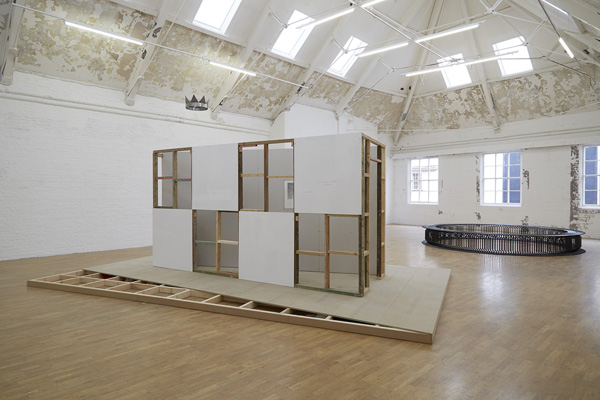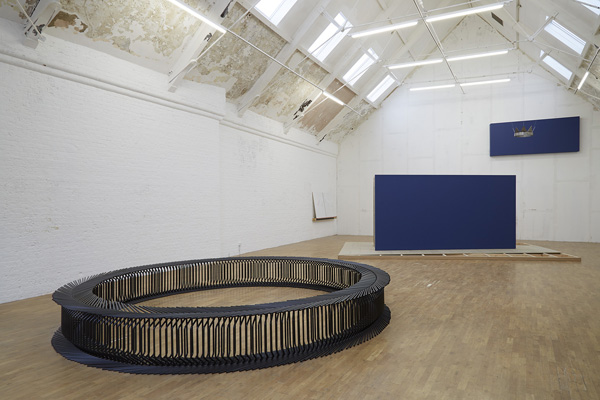
Celebrated as one of Britain’s most compelling post-war performance artists, Stuart Brisley had, by the early 1980s, begun to suspect performance’s limitations, seeking to expand it by incorporating sculpture, photography, film and painting. At the turn of the millennium, Brisley instituted the Museum of Ordure – ordure: shit, trash, dirt, entropy – to build a collection of scatological objects. Its mission statement: firstly, to examine ‘the cultural value of ordure, shit, rubbish’ and, secondly, ‘the waste of human resources through various ownership, production and management regimes’. ‘What is shit for some,’ the Museum reminds us, ‘has value for others.’
‘State of Denmark’, a selected survey of Brisley’s work, which includes a new, eponymously titled installation, is a collaboration between independent curator David Thorp (Modern Art Oxford’s interim director before Paul Hobson) and the Museum of Ordure. The partnership thematizes (and puns on) the relationship between ordure and curating as a form of order and evaluation. Brisley’s 2003 novel Beyond Reason: Ordure, published by Bookworks, tells the story of the Museum of Ordure’s establishment, which is at once a rumination on ordure’s intimations. According to the narrator, ordure has its own organic continuum, primitive and humbling. The body’s processes of ordure enable life but are also symptomatic of its passage. The body is nourished; shit is flushed away. Bodies age. ‘State of Denmark’ reflects on the degradation of the ageing performer’s body, and the more impersonal forces of history that bear upon it.
The earliest work on display here, Hille Fellowship Poly Wheel (1970/2014), was produced by Brisley while contracted, via the Artist Placement Group, to work at the Hille furniture factory at Haverhill in Suffolk. In line with his left-leaning politics, Brisley joined the shop floor, befriending workers in the metal-polishing room – a method Claire Bishop has suggested anticipated many subsequent approaches to site-specific art. Brisley painted the polishing machinery in the colours of the workers’ football teams and introduced mobile noticeboards by means of which colleagues could communicate openly with one another. Finally, he produced Poly Wheel, a four-metre-diametre sculpture consisting of 212 Robin Day chair bases stacked to form a closed circular structure. Originally displayed vertically for a temporary period outside the factory, for Brisley Poly Wheel symbolized closed labour, work without end. At MAO – toppled, laid horizontally, abstracted from its original site – it had a commanding sculptural presence in the upper gallery. The date ‘1970/2014’ bequests the work to today, making it a live proposal and an ambiguous symbol for the workforce for our times. Brisley’s work at Hille, he believed, confused his identity as an artist, shifting him away from art ‘more into a kind of potentially collective situation’.

Artist Project Peterlee/History Within Living Memory 1976–1977, displayed in the middle galleries, represents an early attempt to expand performance into the social through a continuous engagement with the everyday. With Peterlee inhabitants, who populated the new town from surrounding mining communities, Brisley built an archive of historical photographs and oral testimony over a period of 18 months. The intention was to createa sense of shared working-class identity that would cohere a community and nurture agency and participation amongst its members. It is impossible to know the legacy of Brisley’s activities – allegedly the project was curtailed because it was considered too radical – but a digitized archive is now preserved at the Durham County Record Office. At MAO the bureaucratic display of these type-written documents and photographs in vitrines – an ‘aesthetic of administration’ – is somehow antithetical to the dynamic aspirations of the project. Nevertheless, it remains fascinating for its relation to pioneers of post-war oral history, in particular George Ewart Evans and subsequent archival artistic practices.
By Poly Wheel in the upper gallery was the exhibition’s titular piece, State of Denmark. An iron crown was suspended above a partially clad lumber structure of perpendicular joining walls on a low platform. Each wall was partially covered by removable panels, one side demarcated as open/republican, the other closed/monarchic. Inside was a portrait of a boy prince, apparently caught between these two contradictory systems of governance. Yet the simplistic oppositions set up by the installation seem deceptive: if the structure is open and moveable, might it not also be reconstructed, reconsolidated?
In the basement was undoubtedly the highlight of this exhibition: a four-hour loop of Brisley’s films, including Incidents in Transit (1992–2014), Black Red and White (1997–2009) and his remarkable collaboration with Ken McMullen on the preindustrial origins of performance, titled Being and Doing (1984). Many of these durational pieces, including 10 Days (1978) and Before The Mast (2013) are utterly beguiling, foregrounding the body, Brisley’s enduring medium. It gives us what is strangely absent upstairs: a harrowing sense of the corporeal. In both of these films, two obdurate concerns of ordure arise: the body’s shit and the body’s entropy. In the former, Brisley starves himself for ten days; in the latter, Brisley is an elderly man, rolling in waste.
